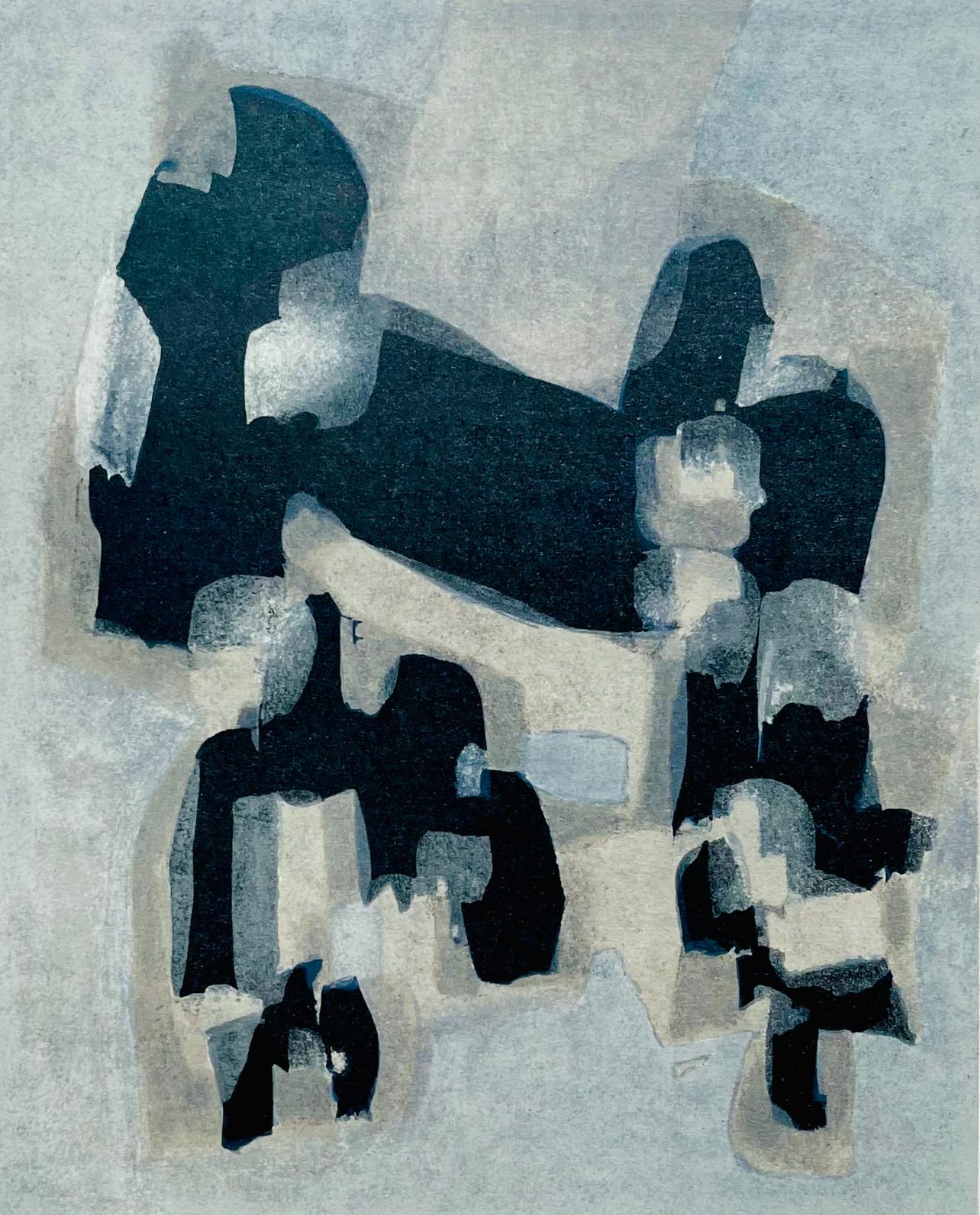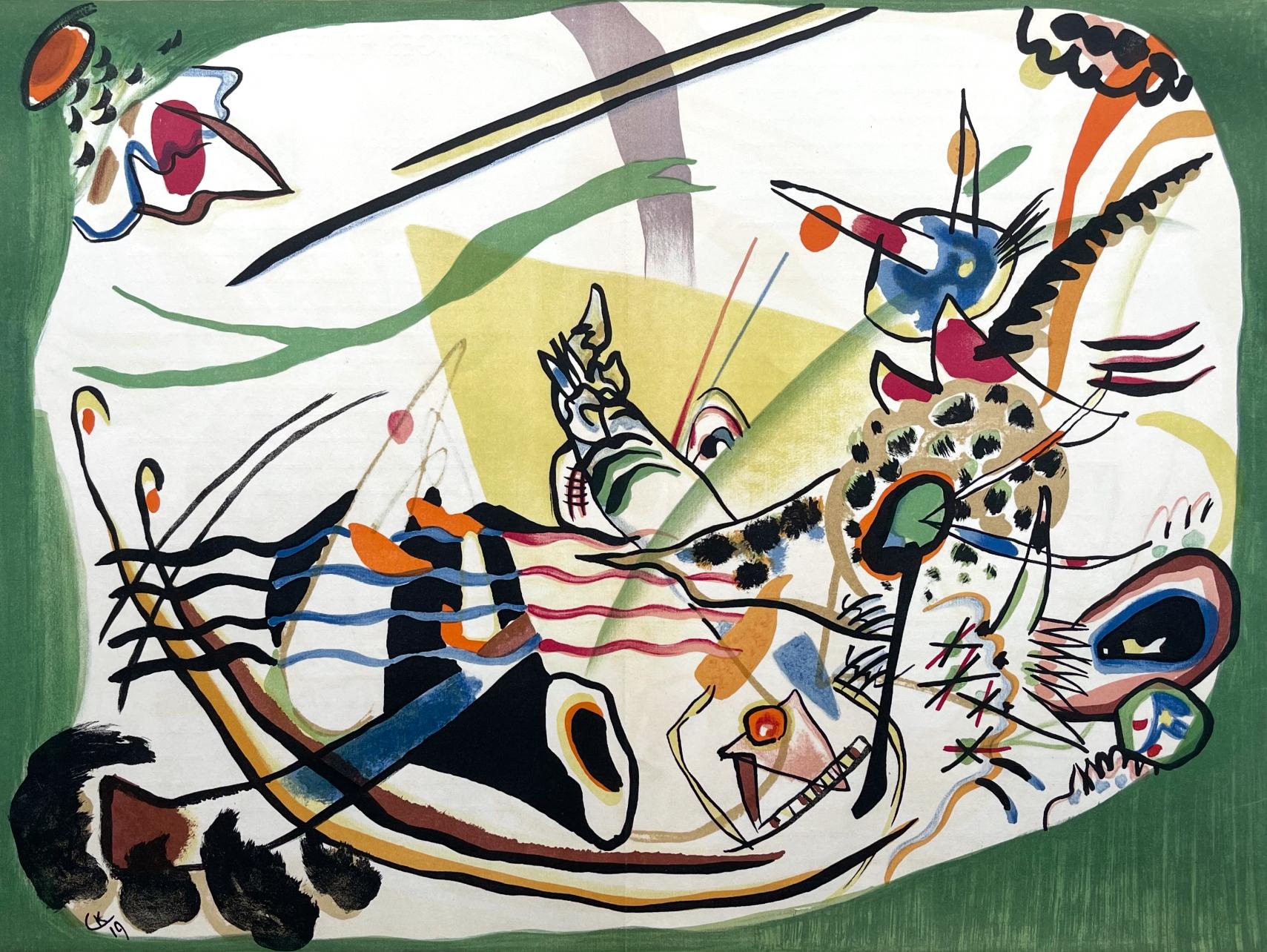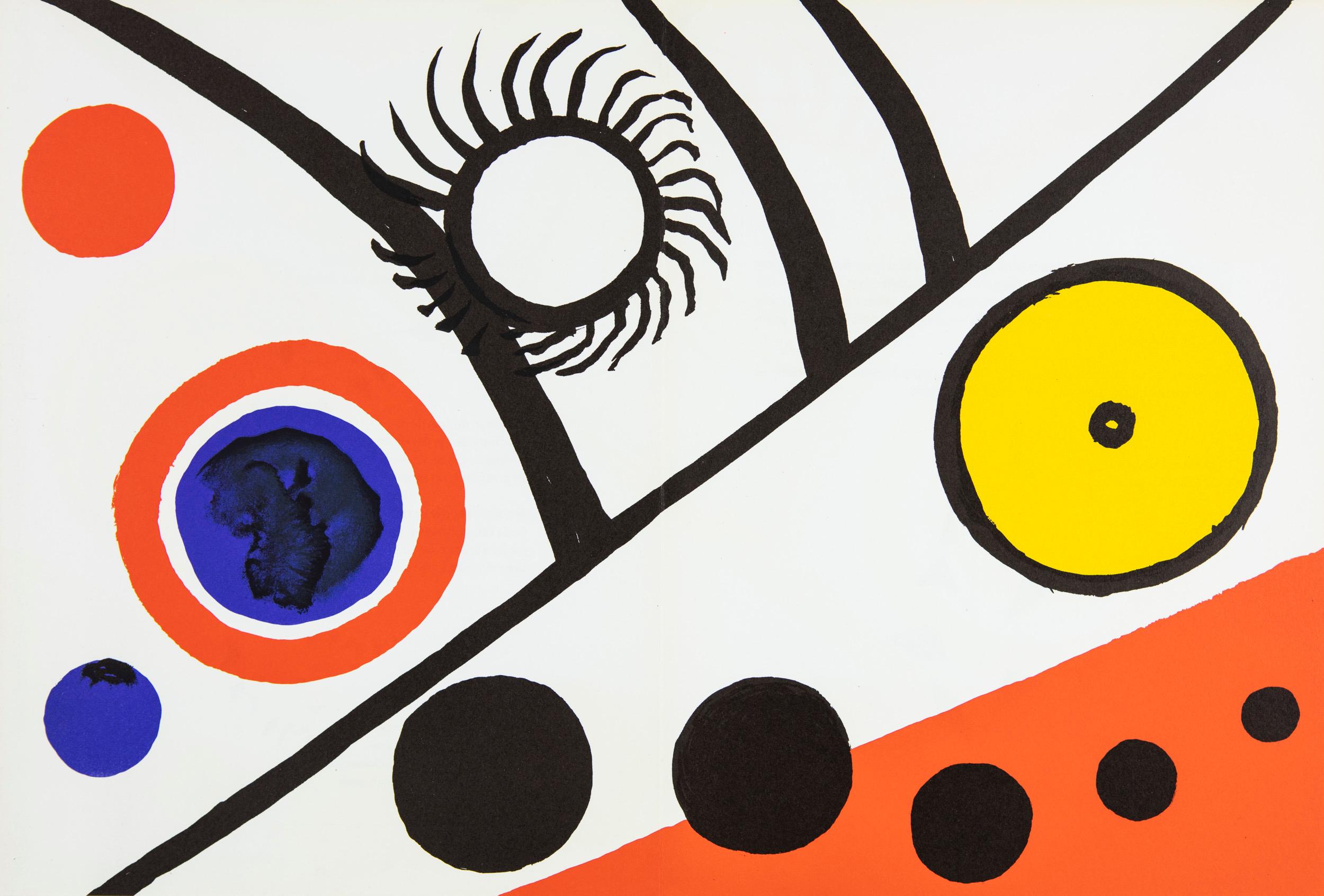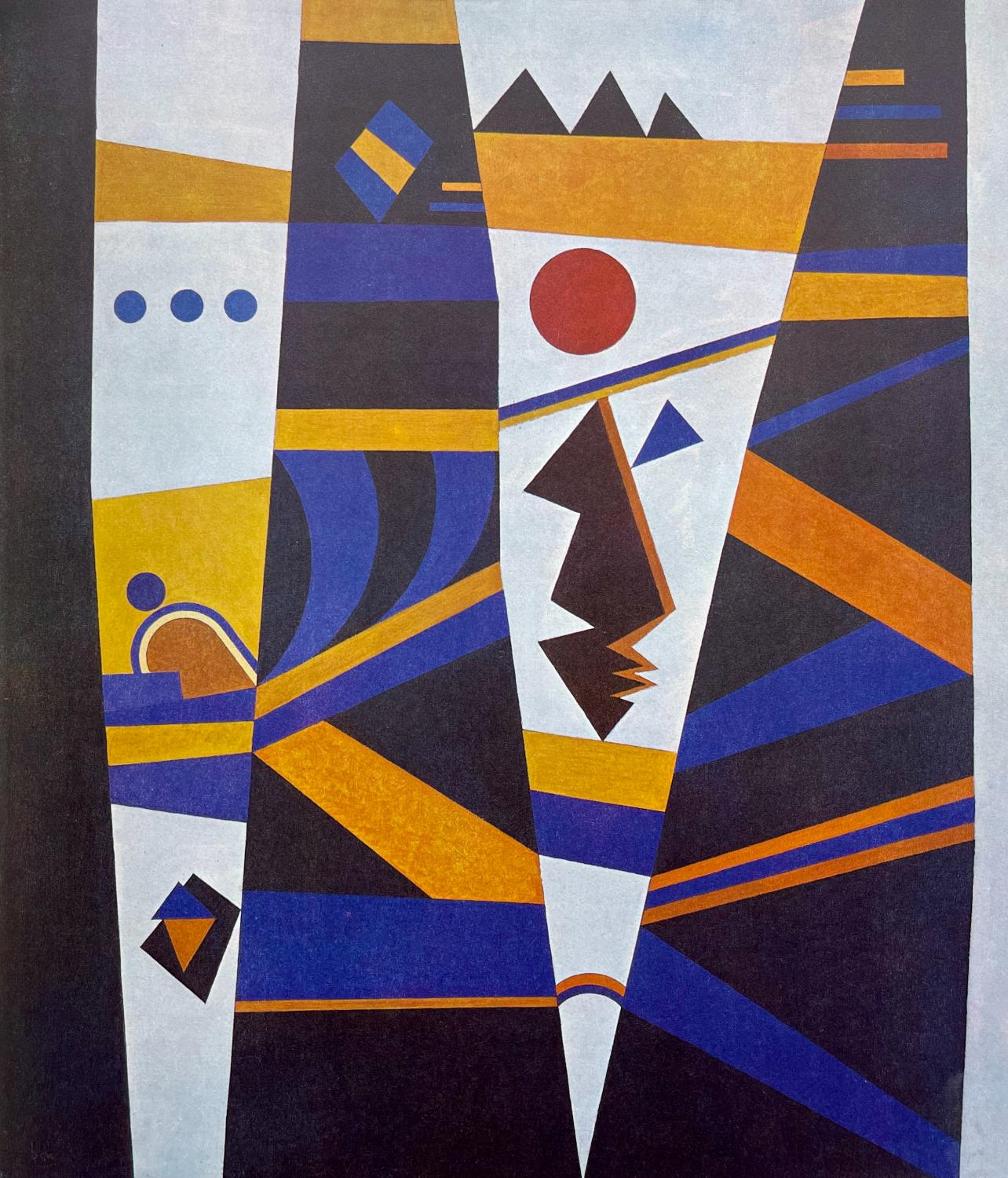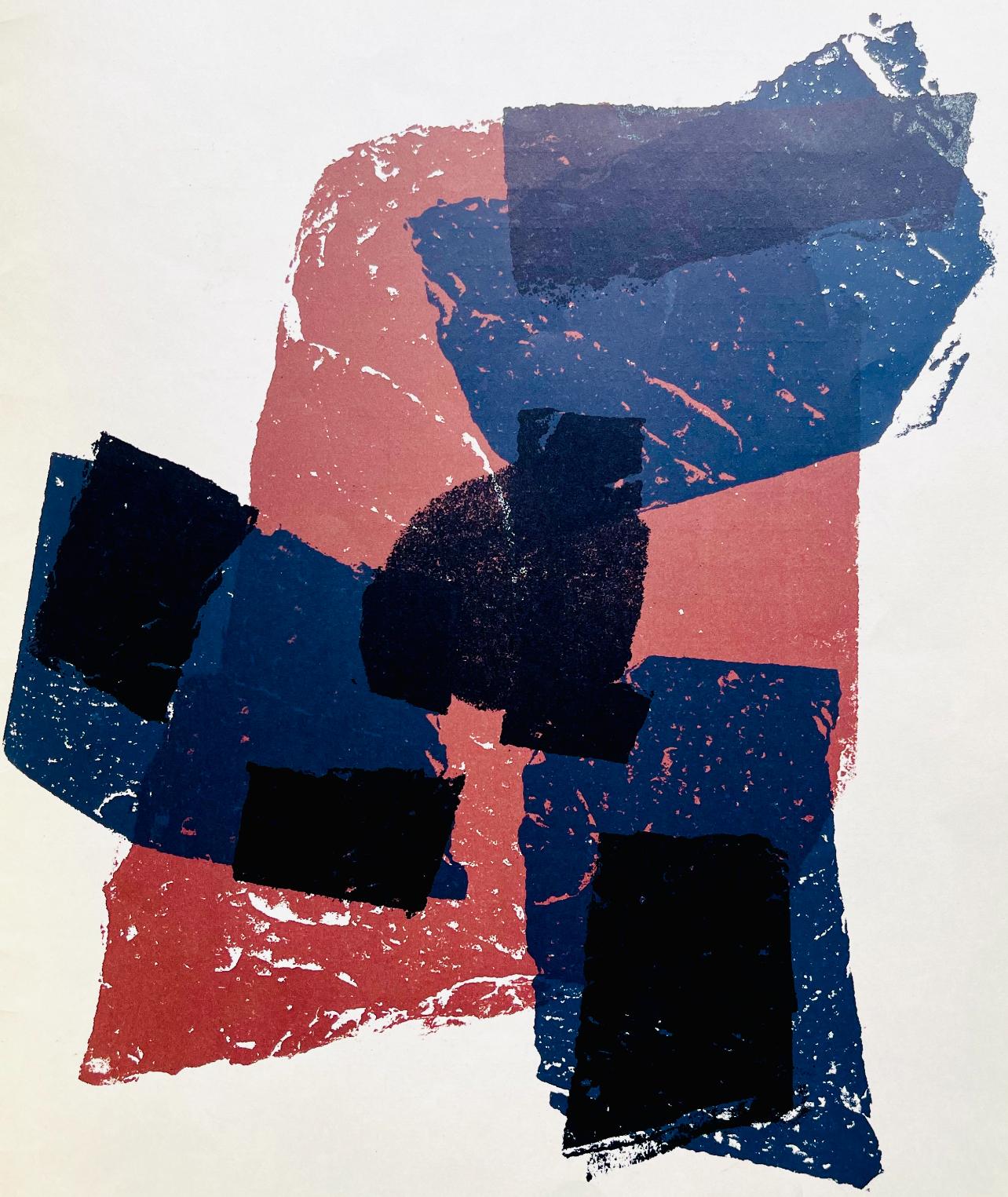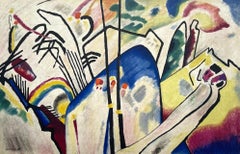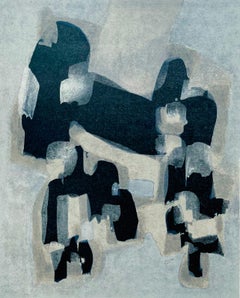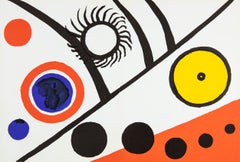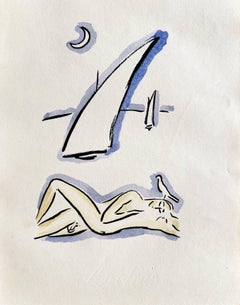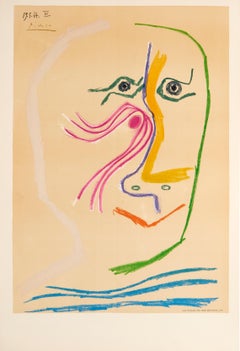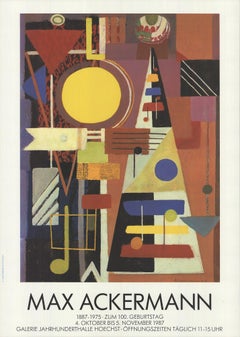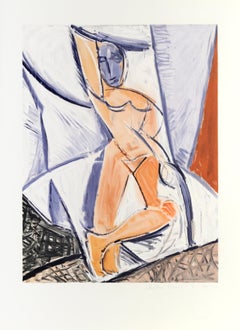Items Similar to Marc, Der Traum, Derrière le miroir (after)
Want more images or videos?
Request additional images or videos from the seller
1 of 10
Marc, Der Traum, Derrière le miroir (after)1962
1962
$716
$89520% Off
£556.50
£695.6220% Off
€634.54
€793.1720% Off
CA$1,027.28
CA$1,284.1020% Off
A$1,118.22
A$1,397.7720% Off
CHF 591.15
CHF 738.9420% Off
MX$13,520.58
MX$16,900.7220% Off
NOK 7,410.71
NOK 9,263.3820% Off
SEK 6,936.41
SEK 8,670.5120% Off
DKK 4,737.18
DKK 5,921.4720% Off
About the Item
Lithograph on vélin paper. Inscription: Unsigned and unnumbered, as issued. Good condition, with centerfold, as issued. Notes: From Derrière le miroir, N° 133-134, 1962. Published by Aimé Maeght, Éditeur, Paris; printed by Éditions Pierre à Feu, Galerie Maeght, Paris. Excerpted from a Christie’s, New York lot essay, The life span of Derrière le Miroir was thirty-five years. Publication began in 1946. Aimé Maeght, initiator of Derrière le Miroir, had already made few attempts to start publications illustrated with fine printed lithographs in colours in the years prior to the launch of Derrière le Miroir. The name, Derrière le Miroir was suggested by Jacques Kober, manager of Galerie Maeght. The gallery had opened in 1945; the first number of Derrière le Miroir was released a year later. For this first issue Geer van Velde was invited to create lithographs to illustrate the publication. The lithographs in the first issue was printed by Mourlot, Paris. The first three issues of Derrière le Miroir were unsuccessful for Maeght as far as the edition size—the initial print-runs were far too large. From 30,000 for the first issue, the number was taken down to 10,000 for numbers two and three, until Derrière le Miroir number four was published in an edition of 1500. Maeght instituted a policy whereby unsold issues were recycled and used for the fabrication of new paper for the coming editions—this served to both conserve resources and also usually result in ultimate edition sizes far less than 1,500. With number four, the permanent format for Derrière le Miroir was established. Lithographs in colours were key; text was limited to comments on the featuring artist's exhibition taking place in the Galerie Maeght, and this catalogue format was defining to Derrière le Miroir. Galerie Maeght took on the leading role in Paris and presented all main artists including Braque, Matisse, Chagall, Léger, Bonnard, Chillida and many more. So too did Derrière le Miroir. The idea of a magazine was meanwhile still on the mind of Aimé Maeght. He found an insert as a solution. Two, and later four, pages of art review were inserted from 1952 onwards. In 1968 this find had ripened to independency and the dream of Aimé Maeght was now a tangible fact named l'Art vivant. Derrière le Miroir was on it's own again. Over 250 issues in a row. At that point publisher Aimé Maeght wished to make a mark with the publication of an hommage to all who once contributed to the magazine which came in the form of issue number 250, but was delayed by the death of Aimé Maeght. It was published after number 253 in 1982 and became a tribute to Aimé and Marguérite Maeght and 35 years of friendship with artists and poets. The era of Derrière le Miroir was closed with that final publication.
FRANZ MARC (1880-1916) was a German painter and printmaker who is known for the intense mysticism of his paintings of animals, and for bright coloration. Marc was also the founding member of "Der Blaue Reiter" (The Blue Rider), a magazine which was run by fellow artists of the Expressionist movement. The artists associated with Der Blaue Reiter, including Marc, Kandinsky, and Macke, were important pioneers of modern art of the 20th century. He was drafted to serve in the German Army at the beginning of World War I, and died two years later at the Battle of Verdun.
- Creation Year:1962
- Dimensions:Height: 15 in (38.1 cm)Width: 22 in (55.88 cm)
- Medium:
- Movement & Style:
- After:Franz Marc (1880-1916, German)
- Period:
- Condition:
- Gallery Location:Southampton, NY
- Reference Number:1stDibs: LU1465215171302
About the Seller
4.9
Platinum Seller
Premium sellers with a 4.7+ rating and 24-hour response times
Established in 1978
1stDibs seller since 2021
1,213 sales on 1stDibs
Typical response time: <1 hour
- ShippingRetrieving quote...Shipping from: Southampton, NY
- Return Policy
Authenticity Guarantee
In the unlikely event there’s an issue with an item’s authenticity, contact us within 1 year for a full refund. DetailsMoney-Back Guarantee
If your item is not as described, is damaged in transit, or does not arrive, contact us within 7 days for a full refund. Details24-Hour Cancellation
You have a 24-hour grace period in which to reconsider your purchase, with no questions asked.Vetted Professional Sellers
Our world-class sellers must adhere to strict standards for service and quality, maintaining the integrity of our listings.Price-Match Guarantee
If you find that a seller listed the same item for a lower price elsewhere, we’ll match it.Trusted Global Delivery
Our best-in-class carrier network provides specialized shipping options worldwide, including custom delivery.More From This Seller
View AllWassily Kandinsky, Composition IV, from Derriere le miroir, 1955 (after)
By Wassily Kandinsky
Located in Southampton, NY
This exquisite lithograph after Wassily Kandinsky (1866–1944), titled Komposition IV (Composition IV), from the folio Derriere le miroir, No. 77–78, originates from the 1955 edition ...
Category
1950s Modern Abstract Prints
Materials
Lithograph
$956 Sale Price
20% Off
Free Shipping
Ubac, Composition, Derrière le miroir (after)
By Raoul Ubac
Located in Southampton, NY
Lithograph on vélin paper. Inscription: Unsigned and unnumbered, as issued. Good condition. Notes: From Derrière le miroir, N° 130, 1961. Published by Aimé Maeght, Éditeur, Paris; pr...
Category
1960s Modern Abstract Prints
Materials
Lithograph
Wassily Kandinsky, Green, from Derriere le miroir, 1957 (after)
By Wassily Kandinsky
Located in Southampton, NY
This exquisite lithograph after Wassily Kandinsky (1866–1944), titled Grun (Green), from the folio Derriere le miroir, No. 101–103, originates from the 1957 edition published by Maeg...
Category
1950s Modern Abstract Prints
Materials
Lithograph
$956 Sale Price
20% Off
Free Shipping
Alexander Calder, Composition with Circles, from Derriere le miroir, 1976
By Alexander Calder
Located in Southampton, NY
This exquisite lithograph by Alexander Calder (1898–1976), titled Composition aux Cercles (Composition with Circles), from the folio Derriere le miroir, No. 221, originates from the 1976 edition published by Maeght Editeur, Paris, and printed by Mourlot Freres, Paris, 1976. Composition aux Cercles reflects Calder’s mastery of rhythm, motion, and form—translating the dynamic energy of his sculptural works into bold, abstract compositions on paper, rich with color and movement.
Executed as a lithograph on velin paper, this work measures 15 x 22 inches, with centerfold as issued. Unsigned and unnumbered as issued. The edition exemplifies the superb craftsmanship of Mourlot Freres, Paris.
Artwork Details:
Artist: Alexander Calder (1898–1976)
Title: Composition aux Cercles (Composition with Circles), from the folio Derriere le miroir, No. 221
Medium: Lithograph on velin paper
Dimensions: 15 x 22 inches (38.1 x 55.88 cm), with centerfold as issued
Inscription: Unsigned and unnumbered as issued
Date: 1976
Publisher: Maeght Editeur, Paris
Printer: Mourlot Freres, Paris
Condition: Well preserved, consistent with age and medium
Provenance: From the folio Derriere le miroir, No. 221, published by Maeght Editeur, Paris; printed by Mourlot Freres, Paris, 1976
Notes:
Excerpted from the folio (translated from French), The illustrations on the cover and pages 3, 4-5, 6, 9, 12-13 and 16 of this issue of "Behind the Mirror" are original lithographs by Calder printed at l'imprimerie Arte, Adrien Maeght. It was printed a luxury edition on velin d'Arches in CL numbered examples.
About the Publication:
Derriere le miroir (Behind the Mirror) was one of the most important art publications of the 20th century, created and published by Maeght Editeur in Paris from 1946 to 1982. Founded by the visionary art dealer and publisher Aime Maeght, the series served as both an exhibition catalogue and a work of art in its own right, uniting original lithographs by leading modern and contemporary artists with critical essays, poetry, and design of the highest quality. Printed by master lithographers such as Mourlot Freres and Arte, Derriere le miroir became synonymous with the artistic vanguard of postwar Europe. Each issue was devoted to a single artist or theme and published to accompany exhibitions at the Galerie Maeght in Paris, featuring works by Pablo Picasso, Henri Matisse, Georges Braque, Joan Miro, Marc Chagall, Alexander Calder, Fernand Leger, and Alberto Giacometti, among others. The publication reflected Maeght’s belief that art should be both accessible and elevated—an ideal realized through its luxurious production values, meticulous printing, and collaboration with the greatest creative minds of its time.
About the Artist:
Alexander Calder (1898–1976) was an American sculptor, painter, and printmaker whose pioneering innovations in kinetic art revolutionized 20th-century sculpture and transformed modern visual language. Born in Lawnton, Pennsylvania, into a family of artists, Calder initially trained as a mechanical engineer at the Stevens Institute of Technology before turning to art at the Art Students League in New York—a combination of technical precision and creative imagination that defined his career. Moving to Paris in 1926, he immersed himself in the avant-garde and formed friendships with Pablo Picasso, Alberto Giacometti, Joan Miro, Wassily Kandinsky, Salvador Dali, Marcel Duchamp, and Man Ray, whose ideas profoundly shaped his artistic philosophy. From Picasso, he absorbed structural invention; from Miro, lyrical abstraction; from Kandinsky, spiritual geometry; and from Duchamp and Man Ray, the courage to merge intellect and play. In Paris, Calder created his famous Cirque Calder, a miniature mechanical circus that introduced motion and performance as central components of sculpture, and by the early 1930s, he invented the mobile—a term coined by Duchamp—to describe his delicately balanced, moving sculptures that responded to air currents. Later, Jean Arp would name his stationary counterparts stabiles. These two inventions—sculptures that could either float and spin gracefully or stand monumentally still—transformed art into a dynamic dialogue between movement, balance, and space. Calder’s signature forms, painted in vivid reds, blacks, blues, and yellows, embodied both joy and precision, creating an art that was at once abstract, organic, and deeply human. Like Kandinsky and Miro, he viewed art as a form of rhythm and emotion; like Duchamp, he embraced innovation and humor; and like Giacometti and Dali, he was fascinated by perception, structure, and the unseen forces of motion. His monumental public sculptures—such as La Grande Vitesse (1969) in Grand Rapids and Flamingo (1973) in Chicago—redefined public art as a symbol of civic optimism and modern progress. A key bridge between European modernism and American abstraction, Calder’s influence extended to artists including Jean Tinguely, George Rickey, Donald Judd, Ellsworth Kelly, Richard Serra, and Olafur Eliasson, whose works in kinetic and spatial art continue to echo his vision. His gouaches, prints, and jewelry carried the same balance and movement as his sculptures, revealing a unified language of rhythm across media. Represented in every major modern museum—including MoMA, the Guggenheim, the Tate, and the Centre Pompidou—Calder remains celebrated for merging engineering, color, and poetry into an art of pure equilibrium. Standing alongside Pablo Picasso, Alexander Calder, Alberto Giacometti, Salvador Dali, Joan Miro, Wassily Kandinsky, Marcel Duchamp, and Man Ray, he remains one of the cornerstones of modern art—a visionary whose works breathe with motion, grace, and joy. His highest auction record was achieved by Poisson Volant (Flying Fish) (1957), which sold for $25.9 million at Christie’s, New York, on May 15, 2014, reaffirming Alexander Calder’s enduring legacy as one of the most inventive, dynamic, and collectible artists in the history of modern art.
Alexander Calder Composition...
Category
1970s Modern Abstract Prints
Materials
Lithograph
$716 Sale Price
20% Off
Free Shipping
Wassily Kandinsky, Discovery, from Derriere le miroir, 1965 (after)
By Wassily Kandinsky
Located in Southampton, NY
This exquisite lithograph after Wassily Kandinsky (1866–1944), titled Decouverte (Discovery), from the folio Derriere le miroir, No. 154, originates from the 1965 edition published b...
Category
1960s Modern Abstract Prints
Materials
Lithograph
$716 Sale Price
40% Off
Free Shipping
Ubac, Composition, Derrière le miroir (after)
By Raoul Ubac
Located in Southampton, NY
Lithograph on vélin paper. Inscription: Unsigned and unnumbered, as issued. Good condition. Notes: From Derrière le miroir, N° 105-106, 1958. Published by Aimé Maeght, Éditeur, Paris...
Category
1950s Modern Abstract Prints
Materials
Lithograph
You May Also Like
La Garçonne
By Kees van Dongen
Located in OPOLE, PL
Kees Van Dongen (1877-1968) - La Garçonne
Original Lithograph, pochoir from 1925.
Arches paper (no watermark).
Dimensions of work: 23.5 x 18 cm
Publisher: E. Flammarion Éditeur.
...
Category
1920s Modern Figurative Prints
Materials
Lithograph
Hommage a Rene Char after Pablo Picasso
By Pablo Picasso
Located in New York, NY
This colorful lithograph after Pablo Picasso was printed by the Atelier Mourlot in Paris in 1964 and is unsigned*. This image is taken from a drawing in pencil and colored chalk enti...
Category
1960s Modern Abstract Prints
Materials
Lithograph
$2,800 Sale Price
20% Off
Max Ackermann 'Galerie Jahrhunderthalle Hoeschst'
By Max Ackermann
Located in Brooklyn, NY
Paper Size: 33 x 23.75 inches ( 83.82 x 60.325 cm )
Image Size: 26.5 x 19.75 inches ( 67.31 x 50.165 cm )
Framed: No
The original exhibition poster from 1987, issued by a gallery in ...
Category
1980s Modern Prints and Multiples
Materials
Offset
$120 Sale Price
20% Off
Etude pour le nu a la Draperie, Cubist Lithograph after Pablo Picasso
By Pablo Picasso
Located in Long Island City, NY
Leaning against the draped walls, the nude figure in this print by Pablo Picasso print is geometric and fragmented, divided into different shapes. A lithograph from the Marina Picass...
Category
Late 20th Century Cubist Portrait Prints
Materials
Lithograph
STEHENDE KNABE UND ZWEI MADCHEN
By Otto Mueller
Located in Portland, ME
Mueller, Otto. STEHENDE KNABE UND ZWEI MADCHEN. Karsch 67. Lithograph, 1917. 12 3/4 x 9 7/8 inches; 323 x 250 mm. Monogrammed in the stone. Edition of about 300. In excellent conditi...
Category
1910s Figurative Prints
Materials
Lithograph
Composition
By André Masson
Located in OPOLE, PL
André Masson (1896 - 1987) - Composition
Lithograph from 1969.
Dimensions of work: 32 x 25 cm.
The work is in Excellent condition.
Category
1960s Modern Figurative Prints
Materials
Lithograph
More Ways To Browse
Provincetown Woodcuts
Retro Aspen Ski Posters
Revolutionary War Art
Richard Giglio
Ronald Stephen Riddick
Roy Lichtenstein Moonscape
Roy Lichtenstein Sandwich And Soda
Roy Lichtenstein Water Lily
Salvador Dali Normandy
Scott Kahn Painting
Thomas Nason
Vail Vintage Ski Poster
Vail Vintage Ski Posters
Vintage Breckenridge Posters
Vintage Map Los Angeles
Vintage Posters Palm Trees
Vintage Ski Poster Aspen
William Wilkins

